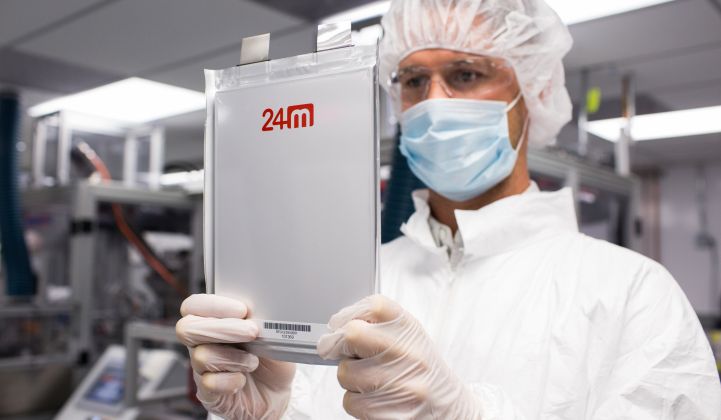Cambridge startup 24M closed a $21.8 million Series D in November to continue commercializing its advanced battery manufacturing process.
The round included new investor Itochu, one of the largest industrial conglomerates in Japan, and returning investors Kyocera and North Bridge Venture Partners.
The money will fund development of a new battery design for electric vehicles, as well as 24M’s long-running effort to establish a commercial-scale manufacturing plant for its semi-solid batteries. The company formed in 2010 based on research by MIT professor Yet-Ming Chiang.
In an interview for a 2015 article, the company told GTM it would be making utility-scale batteries by 2017. The effort took longer than expected, as often happens in translating materials technology from lab to factory. Crucially, the startup has avoided bankruptcy and continued to pull in funding throughout this process, which is more than can be said for many storage materials companies.
A major milestone is within sight. Hitachi is mostly done fabricating the casting and assembly equipment needed for the process, said CEO Rick Feldt. Japanese manufacturer Kyocera is building the first commercial factory using 24M’s process, which should be online in 2019.
The first commercial plant will likely be 100 or 200 megawatt-hour capacity, to prove out the process before moving to giga-scale, Feldt noted.
Chiang’s process, detailed in GTM's previous coverage, aims to speed up battery fabrication compared to conventional lithium-ion manufacturing and requires less capital-intensive production lines. It also reduces the inactive ingredients, like binders and separators, resulting in a 20 percent lower materials cost and a battery that performs more efficiently for longer-duration storage, said CFO Rich Chleboski.
“On all of those fronts we’ll be industry-leading on the cost side,” he said.
Back in 2015, 24M leaders spoke bullishly about hitting $100 per kilowatt-hour price points to undercut the mainstream competition. The company is still aiming for that goal, but sounds a more circumspect tone in its claims.
On an apples-to-apples volume basis, the 24M method should delivery that 20 percent cost savings based on the bill of materials, Feldt said. However, gigafactories can purchase supplies in much greater volumes than the initial factories using 24M’s technique; those economies of scale will mitigate the technology advantage until 24M gets to larger production volumes.
Kyocera’s factory will use a lithium-ferrous-phosphate chemistry optimized for grid storage. But 24M has also gotten excited about a new roadmap for electric vehicle batteries that could slip into its previously developed manufacturing process.
That roadmap consists of densification of active materials, adding a silicon anode (easier said than done without disrupting cycle life) and a dual electrolyte, where the anode and cathode get their own customized electrolyte material, sectioned off by a separator that only allows electrons through.
“It opens up EV dramatically,” Feldt said of the higher energy density that will come from these advances.
The densification step should be commercially viable in around six months, with the silicon anode coming another three to six months after that.
The dual electrolyte will take longer to finalize, on the order of two years. A major challenge there will be slimming down the separator from the standard thickness of 100 microns to 20 or 40 microns.
For all three items, the company says it has demonstrated the basic science, and now needs to engineer its way to a workable product.
“You can’t really schedule commercialization, but the path to commercialization is pretty well understood,” Feldt said.
Further on the horizon, 24M thinks its LFP grid batteries are well suited for the role of gas peaker replacement, because the thicker electrode creates a cost advantage compared to conventional batteries at longer durations, like eight or 12 hours.




